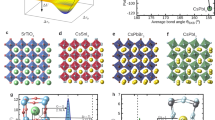Summary
A first-principle chemical model for IVAP-like defects in vitreous silica is proposed. It is shown that these two-centre defects are diamagnetic and, forT<10 K, display a two-level-like energy spectrum. They also exhibit a dipolar nature in agreement with recent experimental data. A close analogy with the basic idea underlying the tunnelling-atom theory is shown, supporting the connection between low-energy excitations in amorphous materials and twofold degenerate equilibrium positions of certain lattice sites. In contrast to previous theories, the present model predicts a large contribution of fast relaxing two-level systems at very low temperatures (T<0.1 K), while slowly relaxing excitations achieve thermal activation only at higher temperature. This result is indirectly confirmed by deviations from linearity of the low-temperature specific heat and seems to bridge in a satisfactory way experimental results which appeared contradictory in the framework of the tunnelling-atom theory as it is usually formulated.
Riassunto
Si propone un modello chimico-fisico per i diffetti di tipo IVAP nella silice vetrosa. Si dimostra che tali difetti a due centri sono diamagnetici e, perT<10 K, si comportano come sistemi a due livelli. Inoltre essi risultano associati a momenti di dipolo elettrico, in accordo con recenti dati sperimentali. Si pone in evidenza una stretta analogia con le ipotesi di base della teoria dei «tunnelling atom», il che comprova la connessione tra le eccitazioni di bassa energia nei materiali amorfi e la doppia degenerazione delle posizioni di equilibrio relative a particolari centri atomici del reticolo. Diversamente dalle teorie precedenti, questo modello prevede un grande contributo di sistemi a due livelli «veloci» (con brevi tempi di rilassamento) a temperature molto basse (T<0.1 K); al contrario, vi sono forti indicazioni che i sistemi a due livelli «lenti» (con lunghi tempi di rilassamento) siano termicamente attivati solo a temperature piú elevate. Questo risultato trova una conferma indiretta nella deviazione dalla linearità del calore specifico a bassa temperatura, e sembra tener conto in modo soddi-sfacente di altri risultati sperimentali che apparivano contraddittori nello schema della teoria dei «tunnelling atom», cosí come viene solitamente formulata.
Резюме
Предлагается физико-химическая модель дефектов, типа IVAP, в стеклообразном кремнеземе. Показывается, что эти двухцентровые дефекты являются диамагнитными и дляT<10 K обнаруживают двухуровневый энергетический спектр. Они также обнаруживают дипольную природу в соответствии с недавними экспериментальными данными. По аналогии с основной идеей, лежащей в основе теории «туннелирующего атома», отмечается связь между низкоэнергетическими возбуждениями в аморфных материалах и двухкратно вырожденными равновесными положениями узлов решетки. В противоположность предыдущим теориям, предложенная модель предсказывает большой вклад быстро релаксирующих двухуровневых систем при очень низких температурах (T<0.1 K), тогда как медленно релаксирующие возбуждения активируются только при высоких температурах. Этот результат косвенно подтверждается отклонениями от линейности удельной теплоемкости при низких температурах и, по-видимому, позволяет удовлетворительно обьяснить экспериментальные результаты, которые противоречат теории «туннелирующего атома».
Similar content being viewed by others
References
P. W. Anderson, B. I. Halperin andC. M. Varma:Philos. Mag.,25, 1 (1972).
W. A. Phillips:J. Low Temp. Phys.,7, 351 (1972).
W. M. Gobau andR. M. Tait:Phys. Rev. Lett.,34, 1220 (1975).
J. C. Lasjaunias, A. Ravex, M. Vandorpe andS. Hunklinger:Solid State Commun.,17, 1045 (1975).
B. Golding, M. V. Schickfus, S. Hunklinger andK. Dransfeld:Phys. Rev. Lett.,43, 1817 (1979).
B. Golding:J. Non-Cryst. Solids,36, 1125 (1980).
P. W. Anderson:Phys. Rev. Lett.,34, 953 (1975).
W. A. Phillips:Philos. Mag.,34, 983 (1976).
M. Kastner andH. Fritzsche:Philos. Mag. B,37, 199 (1978).
J. Zimmermann andG. Weber:Phys. Rev. Lett.,46, 661 (1981).
G. N. Greaves:Philos. Mag.,37, 447 (1978).
N. F. Mott andR. A. Street:Philos. Mag.,36, 33 (1977).
J. Bock andG. Jen-su:J. Am. Ceram. Soc.,53, 69 (1970).
S. Hunklinger andM. V. Schickfus:Amorphous Solids, edited byW. A. Phillips (Heidelberg, 1981), p. 81.
J. C. Lasjaunias, R. Mainard andM. Vandorpe:J. Phys.,39, Supplement C6973 (1978).
W. A. Phillips:Amorphous Solids, edited byW. A. Phillips (Heidelberg, 1981), p. 53.
J. L. Black andB. J. Halperin:Phys. Rev. B,16, 2879 (1977).
M. T. Loponen, R. C. Dynes, V. Narayanamurti andJ. P. Garno:Phys. Rev. Lett.,45, 457 (1980).
J. L. Black:Phys. Rev. B,17, 2740 (1978).
B. Golding andJ. E. Graebner:Phys. Rev. Lett.,37, 852 (1976).
Author information
Authors and Affiliations
Rights and permissions
About this article
Cite this article
Ferrari, L., Russo, G. Two-centre defects and low-energy excitations in vitreous silica. Il Nuovo Cimento D 2, 965–992 (1983). https://doi.org/10.1007/BF02457133
Received:
Issue Date:
DOI: https://doi.org/10.1007/BF02457133



